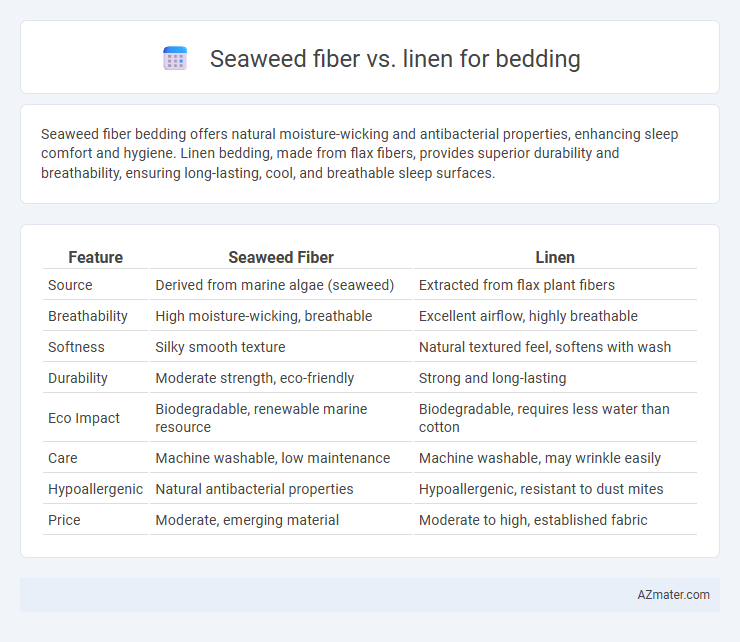Seaweed fiber bedding offers natural moisture-wicking and antibacterial properties, enhancing sleep comfort and hygiene. Linen bedding, made from flax fibers, provides superior durability and breathability, ensuring long-lasting, cool, and breathable sleep surfaces.
Table of Comparison
| Feature | Seaweed Fiber | Linen |
|---|---|---|
| Source | Derived from marine algae (seaweed) | Extracted from flax plant fibers |
| Breathability | High moisture-wicking, breathable | Excellent airflow, highly breathable |
| Softness | Silky smooth texture | Natural textured feel, softens with wash |
| Durability | Moderate strength, eco-friendly | Strong and long-lasting |
| Eco Impact | Biodegradable, renewable marine resource | Biodegradable, requires less water than cotton |
| Care | Machine washable, low maintenance | Machine washable, may wrinkle easily |
| Hypoallergenic | Natural antibacterial properties | Hypoallergenic, resistant to dust mites |
| Price | Moderate, emerging material | Moderate to high, established fabric |
Introduction to Seaweed Fiber and Linen Bedding
Seaweed fiber bedding is made from sustainably harvested seaweed, known for its natural moisture-wicking, antibacterial properties, and eco-friendly production process. Linen, derived from flax plants, offers exceptional breathability, durability, and temperature regulation, making it a popular choice for bedding. Both materials provide unique benefits for comfort and sustainability, but seaweed fiber stands out for its innovative environmental impact and skin-friendly characteristics.
Origins and Production Processes
Seaweed fiber, derived from sustainably harvested seaweed through eco-friendly extraction methods, offers a renewable alternative to traditional fibers with minimal environmental impact. Linen, produced from flax plants grown in temperate climates, undergoes labor-intensive retting and scutching processes to extract durable fibers known for breathability and strength. Both fibers boast natural origins but differ significantly in cultivation environments and manufacturing techniques, influencing their sustainability and texture for bedding applications.
Sustainability and Environmental Impact
Seaweed fiber bedding offers a sustainable alternative to traditional linen by utilizing renewable marine biomass that grows rapidly without fertilizers or pesticides, reducing environmental strain. Linen production, derived from flax plants, requires less water and fewer chemicals than cotton, but still involves intensive land use and processing agents that impact ecosystems. Seaweed fiber's biodegradability and carbon sequestration properties enhance its eco-friendly profile, making it a promising textile for environmentally conscious bedding choices.
Breathability and Moisture-Wicking Properties
Seaweed fiber offers superior breathability and moisture-wicking properties compared to linen, making it ideal for bedding in warm or humid climates. Its natural ability to absorb and release moisture quickly keeps sleepers dry and comfortable throughout the night. Linen, while breathable and moisture-absorbent, tends to retain more humidity, which can reduce overall comfort during extended use.
Softness and Texture Comparison
Seaweed fiber offers a smooth, silky texture that feels exceptionally soft and breathable against the skin, making it ideal for sensitive sleepers. Linen, derived from flax plants, features a natural, slightly coarse texture that softens with each wash but maintains a crisp, airy feel. Both fibers enhance bedding comfort, with seaweed fiber delivering a more consistently smooth softness, while linen excels in durability and moisture-wicking properties.
Hypoallergenic and Antimicrobial Qualities
Seaweed fiber bedding offers strong hypoallergenic properties due to its natural resistance to dust mites and allergens, making it ideal for sensitive skin. Linen also provides excellent hypoallergenic benefits, known for its breathability and moisture-wicking abilities that reduce the growth of bacteria and fungi. Both materials possess antimicrobial qualities, with seaweed fiber incorporating bioactive compounds that inhibit microbial growth, while linen's flax fibers naturally deter harmful microbes, promoting cleaner and healthier sleep environments.
Durability and Longevity
Seaweed fiber bedding offers moderate durability with natural antibacterial properties, but it typically lacks the long-term strength found in traditional fibers. Linen, derived from flax plants, is renowned for exceptional durability and improves with age through repeated washing, making it ideal for long-lasting bedding. Compared to seaweed fiber, linen demonstrates superior resistance to wear and tear, ensuring extended longevity and sustained comfort.
Comfort and Sleep Experience
Seaweed fiber bedding offers exceptional moisture-wicking properties and a silky-soft texture that adapts to body temperature, enhancing comfort throughout the night. Linen, known for its breathability and natural durability, provides a crisp, cooling effect ideal for hot sleepers but may feel rougher initially compared to seaweed fiber. Choosing seaweed fiber promotes a smoother, hypoallergenic sleep surface, while linen's robust weave ensures long-term comfort with increased softness after repeated washes.
Care and Maintenance Differences
Seaweed fiber bedding offers natural antimicrobial properties, requiring less frequent washing compared to linen, which tends to absorb oils and sweat more readily. Seaweed fiber is gentle on fabrics, allowing machine washing at lower temperatures, while linen demands careful handling with cold water washes to avoid shrinkage and maintains better durability with air drying. Both materials benefit from minimal ironing, but linen generally needs more attention to prevent wrinkles and preserve its crisp texture over time.
Cost and Availability in the Market
Seaweed fiber bedding typically costs more than linen due to its niche production and sustainable harvesting processes, leading to limited availability in the market. Linen, derived from flax plants, benefits from widespread cultivation and established supply chains, making it more affordable and readily accessible. Consumers prioritizing budget and ease of procurement often prefer linen, while those investing in eco-friendly innovation may opt for the pricier seaweed fiber options.

Infographic: Seaweed fiber vs Linen for Bedding
 azmater.com
azmater.com